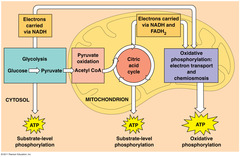Cell Respiration - AP Biology Flashcards
Terms : Hide Images [1]
| 6275105689 | Cellular Respiration | The process by which cells produce energy (ATP) C6H12O6 + 6O2 --> 6 CO2 + 6H2O + energy (oxidative process) |  | 0 |
| 6275105690 | ATP | Consists of adenosine plus 3 phosphates; source of immediate energy (know this structure) |  | 1 |
| 6275105691 | Glycolysis | Anaerobic phase of cellular respiration that breaks down glucose into 2 molecules of pyruvate - Occurs in cytoplasm - Makes 2 Net ATP molecules and 2 molecules of NADH | 2 | |
| 6275105692 | Fermentation | A process that produces a small amount of energy in the absence of oxygen - Begins with glycolysis and produces 2 molecules of pyruvate and then alcohol or lactic acid - Converts NADH to NAD+ by transferring electrons to pyruvate | 3 | |
| 6275105693 | Aerobic Respiration | Consists of Krebs cycle and electron transport chain (ETC) and oxidative phosphorylation - Requires oxygen - Occurs after the anaerobic respiration - Produces 34 ATP - Occurs in the mitochondria |  | 4 |
| 6275105694 | Citric Acid Cycle | Synonym for Krebs Cycle | 5 | |
| 6275105695 | Anaerobic Respiration | Synonym for fermentation | 6 | |
| 6275105696 | Aerobic | With oxygen | 7 | |
| 6275105697 | Anaerobic | Without oxygen |  | 8 |
| 6275105698 | Krebs cycle | Uses 2 acetyl co-A to produces 6 NADH, 2 FADH2, and 2 ATP and CO2 as waste - Occurs in the mitochondrial inner matrix - Part of aerobic respiration - Turns twice for each molecule of glucose (also known as Citric Acid Cycle) | 9 | |
| 6275105699 | Acetyl co-A | coenzyme combined with pyruvate created in middle step; raw material of Krebs cycle | 10 | |
| 6275105700 | ATP synthase | An enzyme that produces ATP as protons (H+) flow down a gradient through chemiosmosis or oxidative phosphorylation |  | 11 |
| 6275105701 | Electron Transport Chain | Energy-coupling reaction that creates H+ gradient in the membrane necessary for the production of ATP through chemiosmosis or oxidative phosphorylation - Energy released from the exergonic flow of electrons is used to pump protons across the membrane to create a proton gradient - Electrons flow down the chain from one carrier molecule to the next in a series of redox reactions - The final hydrogen (H+) acceptor in the chain is oxygen (H2+1/2O2 --> H2O) / Water is the waste product and is exhaled |  | 12 |
| 6275105702 | Oxygen | Final electron acceptor in the ETC | 13 | |
| 6275105703 | Water | Waste product created by at the end of the ETC | 14 | |
| 6275105704 | Chemiosmosis | A process by which ATP is formed as protons flow down a proton gradient through the ATP synthase complex (chemical + ...) |  | 15 |
| 6275105705 | Substrate-Level Phosphorylation | Process that produces a small amount of ATP during glycolysis and the Krebs cycle During this process, the enzyme kinase transfers a phosphate from a susbtrate directly to ADP, forming ATP |  | 16 |
| 6275105706 | Oxidative Phosphorylation | The production of ATP using energy from the electron transport chain. Ends with the production of water. |  | 17 |
| 6275105707 | NADH | Primary electron transporter to the ETC from glycolysis and Krebs cycle | 18 | |
| 6275105708 | FADH2 | Secondary electron transporter to the ETC from Krebs cycle, entering at lower energy levels than NADH | 19 | |
| 6275105709 | NAD+ | Oxidized form of NADH | 20 | |
| 6275105710 | FAD | Oxidized form of FADH2 | 21 | |
| 6275105711 | Redox Reactions | Reduction and oxidation |  | 22 |
| 6275105712 | Reduction | gain of electrons; gain of hydrogen -> for storing energy |  | 23 |
| 6275105713 | Oxidation | loss of electrons; loss of hydrogen -> for releasing energy |  | 24 |
| 6275105714 | Cytochromes | Proteins that help make up the ETC; transport electrons |  | 25 |
| 6275105715 | Inner-membrane space | Mitochondrial part where the ETC pumps protons |  | 26 |
| 6275105716 | Matrix | Site of Krebs cycle in mitochondria |  | 27 |
| 6275105717 | Cristae membrane | site of ETC and ATP synthase complex - contains thousands of copies of the ETC - impermeable to protons (H+) - folds of the mitochondrial inner membrane |  | 28 |
